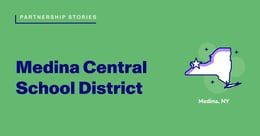
How This Asst. Superintendent is Increasing Access to Student Support
Teachers can’t always be certain that their students are grasping the concepts they’re going over in class—at least until they start grading students' tests or assignments. But what if your district had more real-time visibility into how each of your students are learning, and where they are struggling?
Keith Irish, Assistant Superintendent of Educational Services at South San Francisco Unified School District, shares how Paper is providing their teachers with unprecedented insight into student needs—and informing their district’s broader instructional practices in turn.
What's been the highlight of 2021 so far?
I'm really proud of how the district and our staff have worked together to provide a great education via distance learning and how we've been able to support the digital divide with technology and hotspots. I'm also proud of how we've started to provide educational support for our students in this distance learning format because that was one of the main concerns that students had once we started the school year.
What has made the biggest difference for your district given the last year's shift to distance learning?
Not much has changed; it's just how we're doing it. Paper has been such a vital component in shifting what we're doing here in South City. We have an equity statement on providing each student what they need when they need it. When I think of our statement, I think of Paper.
What pre-Covid challenges does Paper help you solve?
One of the reasons that Paper was very enticing to me was about the opportunity and access. I'm getting lots of emails from neighboring districts, and Paper is one of the things I tell other assistant superintendents about. If anyone asks me what we're doing to help to provide support for all students, I talk about you guys first.
Before, every school created an after-school tutorial program—like a homework center model. It was open access; students could come after school from 3:30 to 5:30. We didn't know who came. We tried to track it. We could never communicate with parents what actually happened. We dealt with teachers asking, "Johnny told me he's going to it. Mr. Irish, can you look to see if he actually did?" And that's what we spent our time doing.
Also, kids are busy, and they have other responsibilities. They would say to me, "a 3:30 to 5:30 just doesn't fit my schedule, Mr. Irish." They're doing homework early morning and late at night. We can't ask our teachers to be awake and respond to students 24/7. It's just not possible.
Our school board agrees that even when we return to in-person learning, we would love to continue this partnership and dissolve the homework center model because we think we can serve more students this way in a more equitable manner.
The parents have also been excited about Paper because we've taken a burden off them—lots of parents were paying for private tutoring or trying to help their kids with schoolwork themselves.
What were some of the hurdles facing your teachers, and how has Paper helped with them?
In my role, I don't get thank yous from teachers very often. With Paper, I got emails from teachers saying, "Mr. Irish, this is great. Why didn't you do this in August? When is the next training coming?"
I can point to one thing just at the secondary level that they would say has been very helpful: the essay support. Teachers can redirect students to take their first draft and work with a qualified tutor. You don't know how many kudos I've got from teachers saying the work students submit is of higher quality, so they're not spending as much time on feedback. We all know how long it takes to grade 170 essays.
Also, math has been a problem area for us, and our math TOSAs (Teachers on Special Assignment) are looking at learning patterns on Paper because they help to align with ed services. They do the work with the teachers about the scope and sequence, the alignment of the curriculum, and the standards. So, it's just given more resources for us so we can adapt quicker. The kids are giving us feedback when we never got it before.
What impact have Paper’s analytics and reporting had in your district?
The amount of data that Paper is able to share with me on a monthly basis is huge because then I can set targets for our site principals around things such as usage.
We love that we can go through the tutoring logs to see what's going on and what kids are struggling with. We're starting to see patterns in what the kids are asking questions on, which informs ed services, which means we can readjust our scope and sequence and talk about instructional practices.
We just have more information than we ever had before. The kids don't even know that they're inadvertently telling me what's going on and what we need to fix and rectify, so that is huge.
Is there anything we didn't ask you about that you think we should know?
What I also appreciate is Paper's customer service. If I need something, I email, and I get a response. I don't know how many other organizations do that once a contract is signed. Usually, what I'm used to with vendors, to be perfectly frank, is we sign the contract, and it's, "I'll see you again when I need to renew." That's not what our site leaders, staff, and I are experiencing with Paper, and I think that's a testament to your business model.
→ Learn about the new approach to academic support
Note: This interview has been edited for length and clarity.


.jpg?width=260&height=136&name=Blog-Articles-No-Type-Favorite-Teachers%20(1).jpg)



